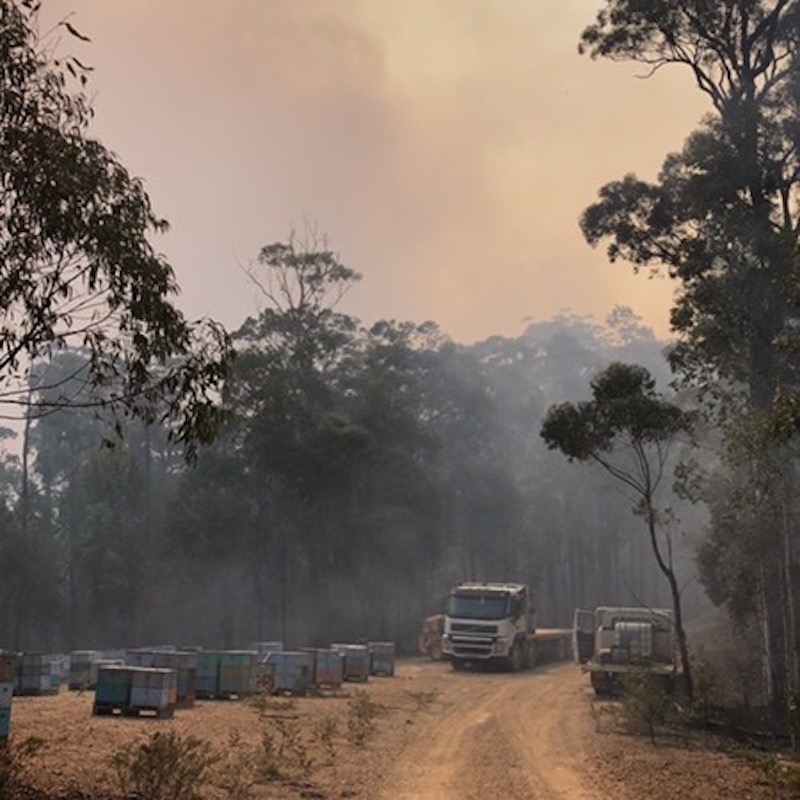
The Kershaws retreat from one of their South Coast sites as fire approaches. Photos: Supplied.
Bee pollinating and honey-making will remain grounded long after the drought and bushfire crises subside says apiarist Laurie Kershaw.
Laurie scrambled to pull thousands of hives from the path of the Currowan blaze on the South Coast.
The Kerhsaws are based between Gundaroo and Bungendore. Annually, they contract their bees for almond pollination in the Murrumbidgee Irrigation Area near Darlington Point and Griffith in July. Then they move them on to flowering canola crops around West Wyalong and Temora.
Many beekeepers rely on the South Coast’s long stretches of giant, pollen and nectar-rich eucalyptus trees to produce honey. Due to the destruction of the forest giants from widespread fires, the beekeepers’ biggest challenge will be the months ahead without flowers and their bees surviving winter. Laurie reckons eucalyptus trees will take anywhere between two and 10 years to recover.
“In some areas, they probably won’t recover,” he said. “The fires were so intense, they blew the bark off spotted gum trees. It will be interesting to see how badly they were burned and how they will recover,” he said.
“We lost over 124 sites in forests and national parks on the South Coast where we put bees on,” Laurie said. “Those sites are all burnt out, so a lot of our resources are gone,” the fourth-generation beekeeper said.
“In one load, 16 hives were burnt, the remaining 116 were scorched. We shifted 2500 hives out of the fire area, some of them we have shifted three times since.”
Laurie works alongside his three sons and his brother Arthur. Using skid-steer loaders from daylight to the late evening, placing hives on pallets and then loading them on trucks, they drove to places they thought were clear of the fire’s treacherous path. But fires kept coming.
“We put the hives down, the fire kept increasing so we had to pick them up again, put them down again and then pick them up again,” he said.
Again, the next morning they moved about 48 kilometres further down near Ulladulla as fire brigades tried back-burning to counter the fierce fire. Two days later they were picking up hives again when the back-burning failed.
Had it not been for the widespread fires, the Kershaws would have worked their way out of the Currowan Forest down to Nerrigundah on the other side of Moruya at Bodalla. But the countryside’s precious stands of eucalyptus trees had gone up in flames. In some areas, roads had closed, bridges had burned down and other beekeepers’ hives sat stranded on burnt ground.
Overall the Kershaws had 3000 hives. They suffered heavy losses, including queen-rearing hives. They had taken the nucleus colonies west towards Jugiong where the bees were to feed on Red River Gums along the Murrumbidgee River. Endless days of dense smoke stopped the bees from flying to gather water. When young queens in nucleus hives hatch they have to fly to mate with drones.
“They won’t fly in smoke, the queens might fly out, but the drones won’t go out and fly, so therefore the hive sits there and goes queen-less,” Laurie says.
Without water, bees, like people, dehydrate quickly. Eventually the hive occupants die. On the days Canberrans sweltered in 40 to 43 degree heat, Laurie estimates the temperatures climbed higher than 45 degrees near Jugiong 120 km away, inflicting a deadly toll on the nucleus colonies.

Laurie Kershaw handling protein pollen which is used to feed bees in the absence of flowers.
In the aftermath of widespread bushfires, the beekeeping industry is suggesting government measures to encourage bee and pollinating habitats similar to the Bee and Butterfly program in the US.
In the meantime, Laurie hopes enough rain eventually arrives to extinguish the fires and a good spring season follows. Ground covers spreading across burnt ground could provide flowers as an alternative to trees lost in the bushfires. Biological control has almost wiped out what beekeepers regarded as the best of the ground covers, Paterson’s curse, which had been a good source of protein.
In lieu of that, the Kershaws have bought tonnes of protein pollen to feed their bees since early December.
The fire is the latest existential threat for the region’s beekeepers. It replaced drought as the primary challenge. Before the fires the Kershaws were carting water to the South Coast for their bees, an unprecedented task for the family.
“Bees drink a lot of water,” Laurie said. “A load of bees consisting of 132 hives will drink a 44-gallon drum [166 litres] of water a day, the equivalent to 1000 litres a week,” he said. He has seen rivers and creeks on the coast dry for the first time in his life. The drought is so widespread eucalyptus trees and ground covers not burned are dying everywhere due to lack of rain.
And with the fire threat in retreat, the focus returns to drought.
Original Article published by John Thistleton on The RiotACT.







